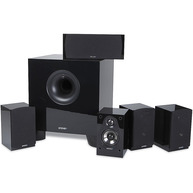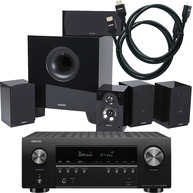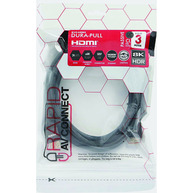Take Classic is a no-compromise collection of high-tech components-satellites, subwoofer and center channel- with all our best stuff packed inside great looking high-gloss black finish.
-
Packaged 5.1 home theater system
-
Compact speakers and subwoofer look great with contemporary flat panels
-
High-gloss black finish has high-tech look
-
Amazing deep bass from 200-watt subwoofer
-
Convergent Source Module (CSM) 3-inch poly-titanium woofer and .75-inch hyperbolic aluminum-dome tweeter - the heart of Energy speakers
-
Ribbed Elliptical Surround woofers create high efficiency, low distortion
-
An aluminum dome tweeter for sonic accuracy
-
Front and rear venting for more powerful bass response
The Lowdown
Take Classic proves that convenience doesn't have to mean compromise. Sure, you can shop for individual home theater components but you won't get better performance, or better looks.
We picked the best of Energy's technologies, so Take Classic can fill your room with hair-rising effects and theater-like sound: hyperbolic aluminum dome tweeters for screaming highs, Convergent Source Modules for clear, crisp dialogue and music and a Ribbed Elliptical Surround on the subwoofer that makes every explosion a room shaking affair. Keyhole slots, threaded inserts and rubber bumpers let you choose how and where to place your speakers.
Take Classic components were developed with Energy's principles in mind:
Flat On-Axis Frequency Response with Wide Bandwidth: Speakers should reproduce the entire audio range in a uniform manner. By ensuring that no one frequency dominates any other, Energy ensures that every note is the way it was intended to be--and the sound as natural as possible.
Wide and Constant Dispersion: Sound at all frequencies radiating from the speaker should be in an even pattern, in all directions throughout the room.
Low Distortion and Resonance: speaker system is distortion- or resonance-free, but Energy has achieved a significantly lower distortion level, a clearly audible improvement.
The Take Classic 5.1 home theater system offers terrific performance and great features.
Take Classic raises the bar for 5.1 speaker system performance. It includes a powerful 200-watt subwoofer with a front-firing port, 8-inch driver and Ribbed Elliptical Surround for bass that you feel as much as hear. The Convergent Source Module (CSM), with its 3-inch poly-titanium woofer and .75-inch hyperbolic aluminum-dome tweeter, focuses sound for clearer dialogue and stirring music. The CSM gives soundtracks a dynamic frequency range and a huge soundstage, for smooth, realistic sound from each satellite speaker and the center channel. Music and movie lovers rejoice! Take Classic puts the passion back into your favorite films.
Maximum Performance Tips
The center channel speaker needs to be centrally located so that the dialogue appears to be coming from the center of the screen. It needs to be above or below the monitor, as closely to it as possible. If you're using a rear projection television, the most likely option is to place it above the screen. If you have a front projection system, you have choices stand mounting, or placement on furniture, for example. It is important, though, to place the speaker so that its front edge is even with the edge of the shelf or stand supporting it. Unwanted diffraction occurs when the center channel is too far back into a cabinet or other surface with edges that could impede sound dispersion.
For left or right front channels, the distance between the speakers should be 6-8 feet at minimum for the best stereo imaging. The optimum room shape is rectangular, with the speakers along one of the shorter walls, facing the opposite side. If possible, do not place speakers against a wall or at rear of a bookshelf; corner placement is usually the worst option. For best results mounting on a rear wall, position the speakers so they flank the main listening area and point toward the front of the room. They should be raised to a height of approximately six feet and should ideally have a space of six feet between them.
The three most common subwoofer locations include corners (which can result in boomy or exaggerated low frequency response), placement along a wall, away from the corner (producing moderate bass performance with increased fidelity over corner placement), or beside a front speaker (creating a better blend with the front speaker, but sacrificing overall volume). Experimentation with subwoofer placement is highly encouraged; slight adjustments can create big differences in sound reproduction. To test subwoofer placement, install it temporarily in your main listening position and walk around the listening room while playing a familiar piece of music until you find the best sounding position.









































